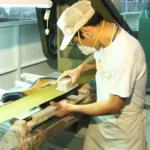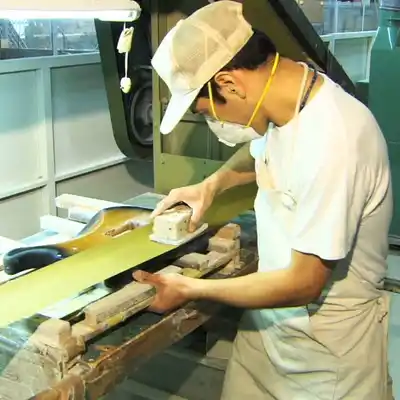
Squier Factories
Many guitarists often get caught up in the product itself and pay less attention to where and how these musical instruments are produced.
Let’s explore Squier factories – the spine of the brand’s production line.
Table of Contents
Squier Japan Factory
Squier is a subsidiary of Fender, one of the world’s leading guitar manufacturers. While Fender’s American-made instruments have long been lauded for their quality, the company ventured into overseas production in the 1980s to offer more affordable alternatives. Thus, the Squier brand was born, and with it came the need for dedicated factories to produce these instruments.
Japan and the Birth of Squier
In the late 1970s and early 1980s, Fender faced a unique challenge. The market was flooded with high-quality, inexpensive Japanese copies of their guitars. These copies were not only affordable but were sometimes on par or even superior in quality to Fender’s American-made offerings.
To address this, Fender decided that if they couldn’t beat them, they’d join them. They started a collaboration with Japanese manufacturers to produce official Fender guitars, effectively utilizing the Japanese knack for precision and craftsmanship to their advantage.
Fujigen Gakki Factory
The Fujigen Gakki factory is perhaps the most well-known Japanese factory involved in the early days of Squier production. Located in Matsumoto, this factory was renowned for its craftsmanship. Instruments from this factory, particularly from the early 1980s, have since become collectible and are known for their quality.
JV Series
The initial batch of Japanese-made Fender guitars bore the serial number starting with “JV“, which stands for “Japanese Vintage”, followed by a series of numbers. These JV guitars, made between 1982 and 1984, are highly regarded by collectors and players alike. They were precise replicas of vintage Fenders and were made using many of the same techniques and materials as the original American instruments from the 1950s and 1960s. For more information about these serials see Fender serial number lookup.
Transition to Squier Branding
As the collaboration between Fender and its Japanese partners continued, there was a need to differentiate between the American-made Fenders and the Japanese-made ones. Hence, the Squier name, which had previously been used by Fender for their string products, was chosen as the brand for these Japanese-made instruments.
The quality of these early Squier guitars was so good that they are often mistaken for their American counterparts, leading to their enduring reputation.
Economic Dynamics
As the 1980s progressed and Japan’s economy grew stronger, production costs in the country began to rise. This economic shift led Fender to look at other locations, such as Korea, Mexico, and later China and Indonesia, for more cost-effective production. However, the legacy of Japanese-made Squier (and Fender) instruments remains intact.
Squier Korea Factories
The 1990s saw a shift to Korean factories, such as the renowned Samick facility, which helped Squier maintain quality while diversifying its production locations.
Transition to Korea
As we touched upon earlier, the 1980s saw Japan’s economy boom, and as production costs began to rise, many companies, including Fender, sought more cost-effective manufacturing solutions. Enter South Korea, a nation quickly becoming known for its blend of quality craftsmanship and competitive production costs.
Samick Factory: A Key Player
One of the most influential factories in Korea during the early days of Korean-made Squier guitars was Samick. Founded in 1958, by the 1980s, Samick had grown to be one of the largest guitar manufacturers in the world, producing instruments under its own name and manufacturing guitars for many other brands, including Squier.
The guitars produced by Samick for Squier during this period were, and still are, regarded as reliable instruments that offer good value for money. Many guitarists and collectors believe that the quality of some of these Korean-made Squiers rivals that of their Japanese counterparts, particularly when considering their price point.
E Serial Numbers
Korean-made Squier guitars from the late 1980s and early 1990s often bore serial number starting with the letter ‘E’ (often followed by a six or seven-digit number). These are generally indicative of instruments made in the Samick factory. These “E” serial guitars have since gained a reputation for their build quality and are sought after in the used market.
Cort and Sungham Factories
Apart from Samick, other notable factories in Korea producing for Squier included Cort and Sungham. Cort, in particular, is another significant name in the world of guitar manufacturing. Like Samick, Cort produces instruments under its brand and has been an OEM (Original Equipment Manufacturer) for numerous other brands.
Diversification
Korea served as a major hub for Squier production throughout the late 1980s and much of the 1990s. However, as the global market continued to evolve, Fender, like many other companies, diversified its manufacturing, incorporating factories from countries like Indonesia and China to cater to different market segments and price points.
Squier China Factories
Rise to Manufacturing Supremacy
From the late 1990s onward, China rapidly became the world’s manufacturing powerhouse. The combination of a vast workforce, developing infrastructure, and favorable economic policies made it an attractive hub for many companies, including those in the musical instrument industry.
Squier’s Chinese Journey
By the 2000s, several Squier models began to be produced in China. These guitars were positioned to cater to beginner and intermediate players, offering good value for money.
Quality and Consistency
One misconception is that Chinese-made guitars are inherently inferior. While there was variability in the early days, modern Chinese factories, with access to better technology and improved quality control processes, have consistently produced reliable instruments.
Yako
Yako Musical Instruments Company, headquartered in Taiwan and established in 1993, holds the distinction of being the first company to produce Squier guitars under an OEM agreement in China. While Yako had factories both in Taiwan and mainland China, the production of Squier instruments primarily took place at their factory located in Zhangzhou, southeastern China, approximately 300 kilometers from Hong Kong.
In May 1995, Yako received its inaugural Squier order, which was delivered in August of the same year. This order consisted of 2,000 Squier Bullet SRS Stratocasters. These guitars had been in production since late 1994 and closely resembled the previous Korean Bullets. They shared common features, such as a plywood body and low-quality hardware. However, they were distinguishable by a neck plate that bore the “MADE IN CHINA” stamp and a serial number comprised of the prefix “NC” followed by a 6-digit number. Over the subsequent years, additional Bullets were manufactured, although not all were considered genuine Stratocasters; some were classified as Bullet models.
AXL
AXL Musical Instruments, with multiple factories in China since the late 90s, also produced Squier guitars for Fender, identified by serial numbers beginning with “CA” and “CAE.” In 2004, a state-of-the-art guitar factory in Shanghai marked the culmination of a joint venture between Fender Musical Instruments Corporation and AXL Musical Instruments. This 200,000-square-foot facility was inaugurated with great fanfare just prior to the Shanghai Music Fair. Initially, it focused on producing Fender’s Squier branded guitars for the Chinese domestic market and South America, with plans for international distribution in the future.
Both AXL and Fender expressed great enthusiasm for this new venture. Bill Schultz, Fender’s Chairman and CEO, emphasized the importance of building a stronger presence in the rapidly growing Chinese market and highlighted the role of the new plant in maintaining product quality and expanding into China and South America.
Squier guitars manufactured in the new factory bore the serial number format “CXS.” As of 2023, AXL Marketing and Administration offices are located in Hayward, California, USA, while their manufacturing hub is primarily based in China. They facilitate international shipping from strategically situated warehouse facilities in Shanghai, China’s largest seaport.
GREE
In October 1995, Grand Reward Education & Entertainment (GREE) was founded by Mr. C. W. Tsai. GREE served over ten OEM customers, including Squier, while also promoting its own brand, Farida. The 120,000 sq. ft. Grand Reward factory was situated in Guang Dong province, southern China, occupying 180,000 sq. feet of land. This facility employed 900 individuals, including highly skilled production staff, producing approximately 13,000 instruments per month for export worldwide. A significant portion of their production, 55%, was directed toward the USA, while another 20% was exported to Japan.
Squier Indonesia Factories
A New Hub for Guitar Manufacturing
Indonesia, particularly the island of Java, emerged as a significant center for guitar production in the 1990s and 2000s. Like China, it offered a combination of skilled labor and cost-effective production.
Key Factories
Cort, already a significant name in Korean guitar production, expanded its operations to Indonesia, becoming one of the primary factories producing Squier models in the country. Another noteworthy factory is PT. Wildwood, which has also been instrumental in Squier production.
Cort Factory
Cort Guitars, a subsidiary of Cor-Tek Corporation, was a guitar manufacturing company based in Seoul, South Korea. It specializes in producing musical instruments through OEM contracts for numerous other companies. In 1995, Cort expanded its operations by establishing the P.T. Cort facility in Surabaya, Indonesia, where it manufactured Squier instruments.
Samick Factory
Samick Musical Instruments Co., Ltd. originally hailed from South Korea and was known for its production of musical instruments. In 1992, Samick extended its reach by constructing the P.T. Samick factory in Cileungsi, located near Bogor, Indonesia. This expansive facility, spanning an area of 50 hectares and comprising 11 buildings, provided employment opportunities for approximately 3,000 individuals. At this factory, Samick manufactured a wide range of acoustic and electric guitars through OEM contracts for various major brands, including Squier.
Quality Spectrum
Indonesian-made Squier guitars cover a broad spectrum, from entry-level models to more premium offerings in the Squier lineup. The Classic Vibe series, for instance, has garnered praise for its quality and value, and many of these models are produced in Indonesia.
Quality Control
The process of creating a guitar in a Squier factory involves a combination of traditional craftsmanship and modern machinery. While CNC (Computer Numerically Controlled) machines handle precise cutting and shaping, many aspects, such as assembly and finishing, are often done by hand.
Every Squier factory employs a rigorous quality control process. Guitars undergo inspections at various stages of production. This ensures that any defects, be they aesthetic or functional, are caught early and rectified. This level of scrutiny is part of why Squier has managed to build a reputation for offering value for money – producing instruments that are both affordable and reliable.
Squier factories play a pivotal role in the brand’s global success. Through their dedication to quality, they’ve allowed millions of budding guitarists to access reliable instruments without breaking the bank.

